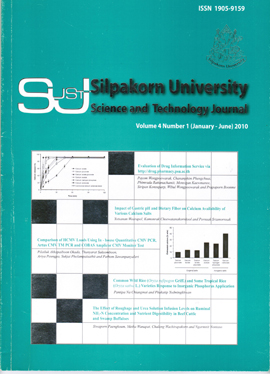Impact of Gastric pH and Dietary Fiber on Calcium Availability of Various Calcium Salts
Main Article Content
Abstract
The objective of this study was to compare calcium release and ionization from commercialcalcium supplements and various salts of calcium with different solubilities. The impact of pH of testfluid and dietary fiber co-administered with calcium supplement on calcium availability was alsostudied. Compressed tablets of six different calcium salts were prepared by direct compression. Calcium release from tablets was tested in simulated gastric fluid without pepsin (SGF, pH 1.2) or fedstate simulated gastric fluid (FSSGF, pH 4.8), using USP dissolution apparatus. The ionized calciumconcentration in test fluid was determined by calcium ion selective electrode. The results demonstratedthat most of the formulations released calcium within 1 hour. Tablets made of higher solubilitycalcium salts demonstrated a faster calcium release. The calcium release from calcium hydrogenphosphate and calcium carbonate tablets in gastric fluid with higher pH showed a slower calciumrelease than in SGF. The dietary fiber co-administered with calcium supplement influenced thecalcium availability, especially in medium with higher pH. The results suggested that most of thecalcium salts could be used as calcium supplement. However, the use of calcium carbonate required anacidic environment in order to be dissolved in the gastrointestinal tract.
Downloads
Article Details
References
Camara-Martos, F., and Amaro-Lopez, M. A. (2002). Influence of dietary factors on calcium bioavailability. Biological Trace Element Research, 89: 43-52.
Delisle, J., Amilot, J., and Dore, F. (1995). Biological availability of calcium and magnesium from dairy products. International Dairy Journal, 5: 87-96.
Gerstner, G. (2003). How can we get more calcium? International Food Ingredients, 3: 24-26.
Levenson, D. I. and Bockman, R. S. (1994) A review of calcium preparations. Nutrition Review, 52: 221-232.
Morohashi, T., Sano, T., Ohta, A., and Yamada, S. (1998). True calcium absorption in the intestine is enhanced by fructooligosac-charide feeding in rats. Journal of Nutrition, 128: 1815-1818.
Riggs, B. L. and Melton L. (1995). The worldwide problem of osteoporosis: Insights afforded by epidemiology. Bone, 17: 505S-511S.
Shils, M. E. (1999). Modern nutrition in health and disease, 9th ed., Baltimore: Williams & Wilkins.
Spencer, H., Scheck, J., Lewin, I., and Samachon, J. (1966). Comparative absorption of calcium from calcium gluconate and calcium lactate in man. Journal of Nutrition, 89: 283-291.
Sriamornsak, P. (2003). Chemistry of pectin and its pharmaceutical uses: A review. Silpakorn University International Journal, 3: 206-228.
Sriamornsak, P., Thirawong, N., Weerapol, Y., Nunthanid, J. and Sungthogjeen, S. (2007). Swelling and erosion of pectin matrix tablets and their impact on drug release behaviour. European Journal of Pharmaceutics and Biopharmaceutics, 67: 211-219.
Wolf, R. L., Cauley, J. A., Baker, C. E., Ferrel, R. E., Charron, M., Caggiula, A. W., Salamone, L. M., Heaney, R. P. and Kuller, L. H. (2000). Factors associated with calcium absorption efficiency. American Journal of Clinical Nutrition, 72: 466-471.
Zafar, T. A., Weaver, C. M., Zhao, Y., Martin, B. R. and Wastney, M. E. (2004). Nondigestible oligosaccharides increase calcium absorption and suppress bone resorption in ovariec-tomized rats. Journal of Nutrition, 134: 399-402.

